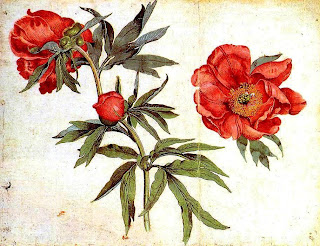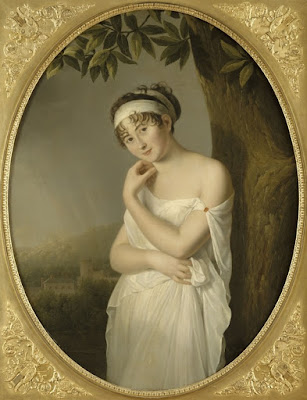 Since 1993, Martin Schongauer's 10" x 13" drawing of Peonies has been in the Getty Museum, Los Angeles. Too fragile for permanent display, it may be in the Getty's exhibition of Renaissance Drawings from Germany and Switzerland, 1470-1600, March 27-June 17, 2012.
Since 1993, Martin Schongauer's 10" x 13" drawing of Peonies has been in the Getty Museum, Los Angeles. Too fragile for permanent display, it may be in the Getty's exhibition of Renaissance Drawings from Germany and Switzerland, 1470-1600, March 27-June 17, 2012.In 2007, a pastel drawing came up on the auction market and it was labeled as 19th century German. An astute Canadian collector who bought it had other ideas and sought expert opinion. Most experts now attribute this drawing to Leonardo da Vinci, and it is called La Bella Principessa. The sitter may be the 13-year old daughter of the Duke of Milan, Bianca Sforza. Interestingly, a fingerprint on the paper matches a fingerprint in Leonardo's un
The circled area of this pastel shows where a fingerprint is found. It matches the fingerprint on a known painting by Leonardo da Vinci. Also, the left-handed hatching is a signature of Leonardo's style.
A badly damaged painting supposedly by a student of Leonardo sold for 45 British pounds in 1958. Only in the past year has it been cleaned and recognized as an authentic Leonardo da Vinci. Called the Salvator Mundi, it was recently part of an exhibition at the National Gallery in London. In the frontal image, Jesus holds a glass globe and stares directly at the viewer while using the blessed gesture. His calm face is full of compassion and kindness. The penetrating sense of life in this image is clearly palpable, as revealed after its cleaning. It has Leonardo's recognizable sfumato, the smoky quality which gives a dark softness to the shadows. It has the iconic and mysterious qualities reminiscent of as the Mona Lisa. Cleaning revealed this Salvator Mundi to be an authentic
Cleaning revealed this Salvator Mundi to be an authentic
 Cleaning revealed this Salvator Mundi to be an authentic
Cleaning revealed this Salvator Mundi to be an authentic
Leonardo da Vinci dating to c. 1500
Martin Kemp, Leonardo expert in England, has identified the rock crystal orb to show the crystalline cosmos in Jesus's hand as something only Leonardo could have painted with accuracy. Leonardo was quite the geologist and Kemp compared the painted example to crystal orbs in the geology collection of the Ashmolean Museum. Therefore, the painting could not have been done by a follower. The last time a painting was discovered to be by Leonardo was 100 years ago.
Only the master Leonardo, who intimately studied nature,
could have portrayed this rock crystal so accurately
Even more remarkable is the fact that a lost painting by Leonardo's young rival, Michelangelo appeared in 2009. This Temptation of St. Anthony is now in the Kimbell Art Museum of Fort Worth. Michelangelo painted this oil and tempera when he was only about 13 years old. The first writer of art history in 1570, Giorgio Vasari described a painting that copied an engraving by Martin Schongauer.
The fact that the two greatest artistic prodigies born in Europe during the 1470s, Albrecht Durer and the divine Michelangelo, admired Martin Schongauer, speaks to that master's incredible reputation as an artist in the 15th century. He died young, but his contribution to later art cannot be overlooked. Although Schongauer's travels probably took him only to the center of Europe: Alsace, Burgundy, Flanders and the Rhineland, his
Michelangelo's newly discovered Temptation of St. Anthony, c. 1487, copies an engraving by Martin Schongauer
